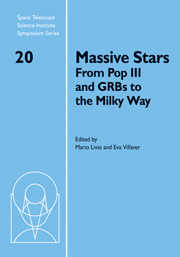Book contents
- Frontmatter
- Contents
- Participants
- Preface
- High-mass star formation by gravitational collapse of massive cores
- Observations of massive-star formation
- Massive-star formation in the Galactic center
- An x-ray tour of massive-star-forming regions with Chandra
- Massive stars: Feedback effects in the local universe
- The initial mass function in clusters
- Massive stars and star clusters in the Antennae galaxies
- On the binarity of Eta Carinae
- Parameters and winds of hot massive stars
- Unraveling the Galaxy to find the first stars
- Optically observable zero-age main-sequence O stars
- Metallicity-dependent Wolf-Rayet winds
- Eruptive mass loss in very massive stars and Population III stars
- From progenitor to afterlife
- Pair-production supernovae: Theory and observation
- Cosmic infrared background and Population III: An overview
Massive-star formation in the Galactic center
Published online by Cambridge University Press: 04 August 2010
- Frontmatter
- Contents
- Participants
- Preface
- High-mass star formation by gravitational collapse of massive cores
- Observations of massive-star formation
- Massive-star formation in the Galactic center
- An x-ray tour of massive-star-forming regions with Chandra
- Massive stars: Feedback effects in the local universe
- The initial mass function in clusters
- Massive stars and star clusters in the Antennae galaxies
- On the binarity of Eta Carinae
- Parameters and winds of hot massive stars
- Unraveling the Galaxy to find the first stars
- Optically observable zero-age main-sequence O stars
- Metallicity-dependent Wolf-Rayet winds
- Eruptive mass loss in very massive stars and Population III stars
- From progenitor to afterlife
- Pair-production supernovae: Theory and observation
- Cosmic infrared background and Population III: An overview
Summary
The Galactic center is a hotbed of star-formation activity, containing the most massive-star-formation site and three of the most massive young star clusters in the Galaxy. Given such a rich environment, it contains more stars with initial masses above 100 M⊙ than anywhere else in the Galaxy. This review concerns the young stellar population in the Galactic center as it relates to massive-star formation in the region. The sample includes stars in the three massive stellar clusters, the population of younger stars in the present sites of star formation, the stars surrounding the central black hole, and the bulk of the stars in the field population. The fossil record in the Galactic center suggests that the recently formed massive stars there are present-day examples of similar populations that must have been formed through star-formation episodes stretching back to the time period when the Galaxy was forming.
Introduction
The Galactic center (GC) is an exceptional region for testing massive-star formation and evolution models. It contains 10% of the present star-formation activity in the Galaxy, yet fills only a tiny fraction of a percent of the volume in the Galactic disk. The initial conditions for star formation in the GC are unique in the Galaxy. The molecular clouds in the region are extraordinarily-dense, are under high thermal pressure, and are subject to a strong gravitational tidal field.
- Type
- Chapter
- Information
- Massive StarsFrom Pop III and GRBs to the Milky Way, pp. 40 - 59Publisher: Cambridge University PressPrint publication year: 2009
- 10
- Cited by



